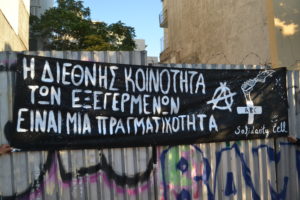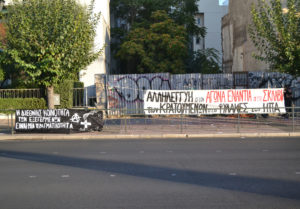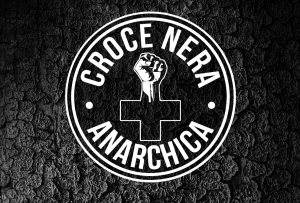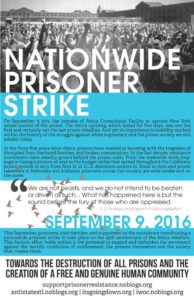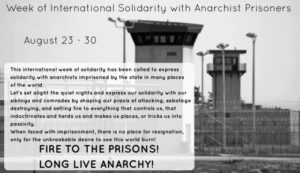
Prisons in the usa – The dark side of slavery in american society
In order to be in the position to understand the importance and necessity of the us prisoners’ struggle, we first need to analyze the role of slavery in the foundation and evolution of the american state and its historical and integral ,until today, link with the capital.
Slavery in its many forms was actually the foundation on which the omnipotence of american overlordship was gradually built. The root of this phenomenon can be traced back in the era when the christian empires of europe started a race to conquest unknown lands, founding colonialism regimes, in the era of brutal genocides of the indigenous populations and the slave trade of the non-white african population.
Since then and until today, the social and political circumstances have rapidly changed, mainly because of a heavy blood tax that has been paid from beneath, towards the direction of the total shaking off of slavery as an institution. However, it continues up until today, more or less covered.
Today’s prisoners’ class and racial composition, the spreading of private prisons, the institutionalization of enforced labor as a form of criminal sanction, the exploitation of prisoners by big companies highlight the fundamental connection between state-capitalism-slavery and prison.
Slavery in the first colonial systems
During the first years of the “new world’s” colonization and until the early 18th century, most of the settlers were not free but were under a status of an idiotype slavery, known as “indentured servitude”, which aimed in equipping the colonies with cheap workforce. The “indentured servant” signed a contract according to which she/he was mortgaging her/his freedom and provide her/his work to a master for a period between 5 to 7 years and, in exchange, the latter covered her/his transportation expenses to the colony. In practice, it was happening by the signature of the contract between the “indentured servant” and the ship owner and the subsequent transferring of the contract to the new master, as soon as the ship arrived to the “new world”. The institution was initially introduced in 1619 through Virginia Company. It has been calculated that 80% of the refugees in the american colonies before american revolution were under this status, while only 40% managed to survive.
“Interventured servants” consisted of three categories : 1) poor immigrants seeking for a better life in the colonies 2)immigrants forced to leave their country because of religious prosecutions or other reasons 3) convicts. It constisted of both white and non-white population. More specifically, in the plantations of the south, the institution favored the further expansion of the land ownership, since it got connected to the headright system. Headright was the right of every coloner in about 4 acres of land. The big landowners managed to expand the landownership since they were both subzitized with the 4 acres for every worker they brought in through the “interventured servitude” system and took profit on the workforce of the “interventured servant” that had in their ownership.
So, although slaves existed in the english colonies already since 1600, this constitution was preferred among plantation owners. But, when the “interventured servants” started to gradually regain their freedom somewhere in the middle of the 17th century, the land they were given was of bad quality and under the danger of indigenous raids, soon resulting in the creation of a poor and unsatisfied social layer, whose existence annoyed the bag landowners who later manned their plantations with permanent slaves.
Moreover, although european “interventured servants” were already under a status of transient slavery compared to the permanent slaves, many of them acted together with non white, african and american indigenous slaves in order to escape, resist to their masters or organize uprisals. The ruling class was displeased by this alliaance and answered with a tactic of separation between the white and the non white population, like happened, for example, in Virginia with the voting of Virginia Slave Codes in 1705. In an case, already during the 18th century, europeans willing to travel to the american continent under the status of “interventured servitude” had considerably decreased, especially after the disclosure of the conditions in the plantations. The ruling class, on the other hand, within the tactic of separation had started to grant privileges and lighter work to the white” inteventured servants” compared with the non-white, african and american indigenous slaves. In this way, the alliance between whites of all layers and racial discrimination gradually started to form a structure. The “interventured servitude” system was abolished after the civil war through the 13th amendment of american constitution in 1865.
First prisons and enforced labor until the end of the civil war
Imprisonment as a form of criminal sanction was established in america a little before the american revolution of 1765. The first period, during which imprisonment was massively used as a means to deal with offenders, the “mentally ill” and the poor, can be found in the early 1800, in the jackson era. During this period, imprisonment and enforced labor constituted the main sanctions for most crimes until the civil war. In the south, however, were slavery was widespread, imprisonment didn’t have much to offer to the sustainment of order, since slaves were in the mercy of their masters. Despite this fact, imprisonment of white people took place in some parts of the south.
The first occasion of enforced labor of prisoners in favor of private companies and of the state is found in 1820 in the prison Auborn in New York. The constitution quickly expanded to the north and, later, to the west. In 1825 in Kentucky, joel scott paid 1000 dollars in order to use the prisoners of the local prison as a work labor in construction projects. After that, he proceeded in building his own private prison to house them. Deals like this can be found in 1844 in Louisiana and in 1852 in California. Despite the above, the main exploitation of prisoners as a work labor and the evolution of the conception around the utilization of the excluded populations will take place after the end of the civil war.
The inclusion of enforced labor in the criminal system (convict leasing)
After the end of the american civil war (1861-1865), capitalism will dominate in the usa and will gradually highlight it into the superpower that is today. Between 1865-1920, corporate interests were served in all government levels. Governments obeyed almost completely to the big companies. In many occasions, industrial corporations were the ones to set the value of their own property for tax reasons, instead of tax inspectors. Private and public sectors were, in a great degree, undividable, for example, in 1880 the owner of the biggest bank in Montana was at the same time its governor. Capitalistic development, however, did not follow a straight line. Since the middle of the 1870s until the middle of the 1890s (a period named the “great depression”), economy wobbles from massive bankrupts, inflation and the merciless competition between the companies for the reduction of labor costs. Within this framework, the utilization of prisoners as a workforce constituted an ideal solution and the institution of “convict leasing” was spread in both the south and the north and the 2/3 of prisoners were assigned to private companies. Companies signed contracts with the state that the workforce would be replaced in case a prisoner got ill or was considered as unsuitable.
The explosive development of the industry and economy was, in a big degree, connected with the specific configuration of the criminal system. The need for cheap labor force leaded to massive criminalization of behaviors and massive arrests. People were sent to prison for insignificant excuses, like gambling and consuming alcohol. While capitalism was gradually evoluting towards its monopolistic form (which will reach after 1890) prisoners started to be assigned only to the most powerful corporations of every state.
The institutionalization of slavery as a criminal sanction through the 13th amendment of the us constitution served as the legal base for the institution. In the south, convict-lease system was spread everywhere and constituted the new way of utilization and disciplination of the recently libareted slaves who were now under a status of discrimination, imposed on them through jim crow’s laws, under the ideological construct of white supremacy. In the prisons of the south after 1985, 90% of the prisoners were non-white. Prisoners were assigned to the mines, to railway companies and to the iron and steel industry. All the extractive companies of the south, as well as the agricultural economy of cotton and sugar, was based on the prisoners’ labor. In the north, there was also a close cooperation between the industries, commercial and agricultural companies and all of the order enforcement authorities as well as the judicial system. Sheriffs, local magistrates, policemen, judges and governors were all working together for the systems’ conservation. Labor unions, syndicates and labor parties reacted to the institution, initially as far as the utilization of prisoners as specialized workforce was concerned, because it was against their interests.
Prison labor was also utilized as a counterweight against the workers’ effort to organize. Companies, in cases of strikes and claimings, could replace their workforce with prisoners who worked under harsh and lethal conditions. This way, a lot of mine strikes were broken.
But, in 1890, during a mine strike, TC&I company tried to use prisoners in order to break the strike. Strikers and their allies, friendly towards the workers’ movement “the knights of labor” started guerilla war with attacks to the prison’s fence and liberated prisoners. They after denied to obey to the governor’s order to return them back and armed conflicts followed. Since 1890, uprisals and prisoners’ strikes started to happen more and more often, especially in the north, where an important percentage of prisoners were veterans of the American civil war, but also, ex- workers.
The development of the prison-industrial complex
Since the 70s and until today, prisons continued to constitute a privileged field of profit and repression in the usa, while, at the same time, through the the prison-industrial complex, we are passing into new forms of social control and surveillance. The interaction and cooperation in the prison system between industry and private prisons, construction companies, prison supply companies, companies exploiting the enforced labor of the prisoners and of the political conservation in general, is conceived by this term.
This way, american state’s propaganda for the social legalization of the army-industrial complex, making huge profit during the cold war, was gradually replaced by the prison-industrial complex, this time, using the excuse of the “war on drugs”.
During the 60s, 70s and 80s, CIA, after secretly getting involved in the drug trade taking place in vietnam and nicaragua, channeled large quantities into the poor neighborhoods of people of color. During the 70s, a lot of companies got transferred out of the usa seeking cheaper workforce resulting in a rise of the unemployment in the poor neighborhoods and a big part of the non-specified unemployed turning to thefts and drug dealing. This phenomenon, offered the suitable political excuse in order for reagan to start, in the middle of the 80s, the campaign of “war on drugs”. A big wave of arrests of non-white people followed this tightening of the legal armory, leading to the overpopulation of prisons. While the expenses for the maintenance and building of new prisons overcame the abilities of the state’s budget, private prisons constituted an advantageous solution, not only for the state but, for the capital as well. In 1984, investors in Tennesee, having connections in the government, structured Corrections Corporations of America (CCA). The idea was to fοund private prisons and rend the bed to the government. The utilization of private prison reached its peak in the 90s during clinton’s presidency, when private prison companies took on the imprisonment of refugees without a residence permits and prisoners of “high risk”. In 2000, private prisons’ industry donated 1,2 millions to 830 candidates. Today, the largest of private prisons’ companies are CCA and GEO Group (ex Wackenhut), while the percentage of inmates in them in 2013 was calculated to be the 8% of the total population of prisoners in the usa.
Together with the institution of private prisons, prisoners’ enforced labor, based -as referred above- on the 13th amendment, is still a field of profit and management of the excluded populations.
Prisoners work without syndicate rights, days off or alliances, under miserable conditions. Their denial to work has as a consequence disciplinary punishments and privilege deprivations. The last 30 years more than 37 states allow private companies to use prisoners with the symbolic payment of between 0,93 and 4,73 dollars a day. Companies exploiting the work of prisoners are, among others, IBM, Boeing, Microsoft, AT&T, Wireless, Texas Instrument, Dell, Compaq, Honeywell, Hewlett-Packard, Nortel, Lucent Technologies, 3Com, Intel, Nothern Telecom, TWA, Nordstorm’s, Revlon, Macy’s, Pierre Cardin, Target Stores, Starbucks and Honda.
Prisoners’ struggles – Resistance finds its ways and spaces to be manifested
As expected, the asphyxiating status of enforced labor as part of the penalty, this disguised form of modern slavery, compresses and crushes the prisoners so much that, little by little, the seed of resistance is being born, a seed growing on anger and desperation. Since quite some time, a series of fermentations inside the American hellhole, which are actually slave galleys, has led to the planning of a concerted struggle inside prisons, targeting towards the definitive abolition of this brutality which euphemistically calls itself “social contribution”. Despite the great difficulties in the communication among prisoners, the thirst for fighting managed to overcome all obstacles so to finally the struggle plan to be communicated in such a degree, that we can maybe be talking about one of the biggest concerted fighting campaigns form the prisoners themselves.
The starting point of such a struggle has been set by the commissions of prisoners themselves on 9/9/16, a date-symbol for the struggles of us prisoners since, 45 years ago, on September 9 1971, the uprisal in the Attica prison of New York took place which constituted the biggest and most dramatic prison uprisal in the usa history. The basic occasion was the murder of the inmate George Jackson from the Black Panthers by the jailers.
As Anarchist Black Cross, we consider that the peak of this struggle has a special importance, since it constitutes a collective scream of dignity form the inside of the modern hellholes of a state that has made imprisonment into a science, being a model and example for every ambitious totalitarian state.
The status of slavery in prisons is the epitome of brutality inside imprisonment conditions since it abolishes the individual status of every person and targets towards her/his total submission between the gears of multinational leviathans.
As anarchists, we cannot whistle with indifference in front of a struggle orienting from the damned of the social margin, being under an idiotype status of slavery and still claiming, even under the adverse conditions of imprisonment, a breath of dignity and self-determination.
The inmates will conduct their struggle by actually denying the procedure of enforced labor, carrying out an abstention of their predicted duties, actually a kind of strike from inside the prison, which is being punished with disciplinary punishments and isolation. A struggle in the root of which there is political disobedience and sabotaging to corporate interests which have identified themselves with the most ruthless forms of exploitation.
The prisoners have outwardly addressed a call for the support of their fight from whoever feels that this struggle has anything to do with her/him and finds a piece of herself/himself inside it.
Inside this framework, as Anarchist Black Cross-solidarity cell we had conducted an event and notification on 4/8 in the squat Themistocleous 58, together with comrades from the translating network of antireport Contra Info, during which, a comrade from Anarchist Black Cross of Portland had extensively spoken on these issues aiming to the notification of the domestic anarchist movement for the struggle that would follow from 9/9.
We are willing to manifest our solidarity to the inmates of us prisons by any means and for all the duration of their struggle. Towards this direction, we are calling all the collectives, all the Anarchist Black Cross cells internationally but also anyone wishing to support in her/his way, to concert our powers in an International Day of Solidarity which can be a point of reference for the international solidarity movement for that struggle and will constitute an occasion for further sharpening of our later actions. We propose that day to be the 1st of October.
We consider that the perspectives, the at-stake-issues, and the stockpile that this specific struggle can leave behind, constitute an open challenge for every fighter wanting to contribute to the conduct of an internationalized and concerted struggle inside and out of prisons, against the modern slavery and the economical dictatorship of multinational companies.
Solidarity and Strength to the struggle of the inmates in the us prisons!
Struggle is the only perspective in order to live with dignity!
Fire to the prisons!
Anarchist Black Cross- solidarity cell

